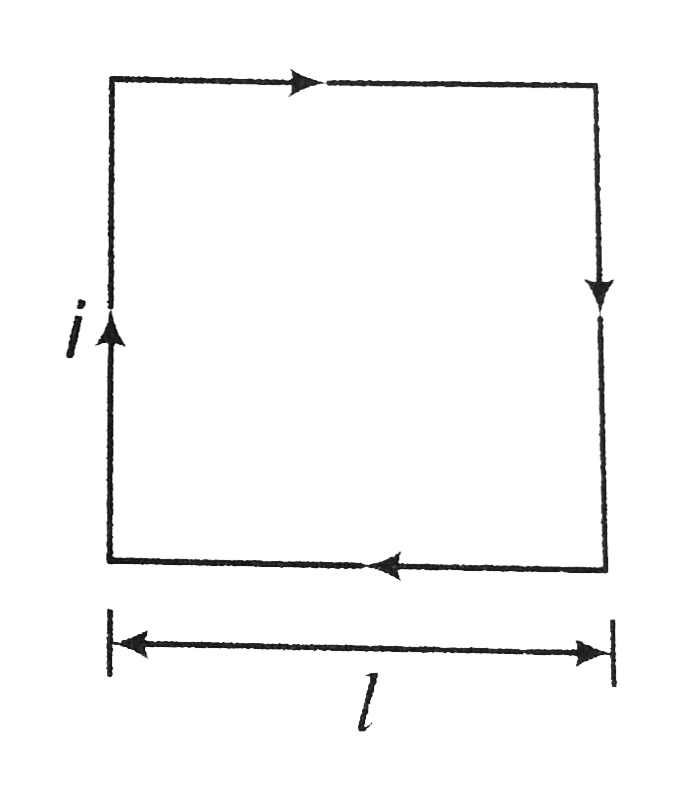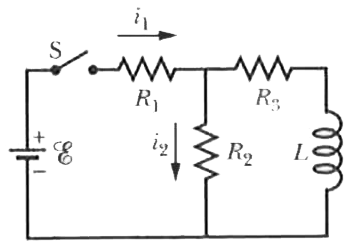A closed cure encircles several conductors. The line integral ∫B.dI around this curve is 3.83×10−7T−m
a. What is the net current in the conductors?
b. If you were to integrate aroundthe curve in the opposite direction, what would be the value of the line integral?
a. ∫B.dI=μ0i≠t
∴i≠t=∫B.dIμ0=3.83×10−74π×10−7=0.3A
b. In opposite direction, line integral will be negative.
Topper's Solved these Questions
- BOOK - DC PANDEYCHAPTER - MAGNETICSEXERCISE - Exercise160videos
MAGNETICS
- BOOK - DC PANDEYCHAPTER - MAGNETICSEXERCISE - INTRODUCTORY EXERCISE1videos
MAGNETICS
- BOOK - DC PANDEYCHAPTER - MAGNETIC FIELD AND FORCESEXERCISE - Medical entrance s gallery59videos
MAGNETIC FIELD AND FORCES
- BOOK - DC PANDEYCHAPTER - MAGNETISM AND MATTEREXERCISE - Medical gallery1videos
MAGNETISM AND MATTER
Similar Questions
A closed curve encircles several conductors. The line integral ∮→B.→dl around this curve is 3.83×10−4Tm.
(a) What is the net current in the conductor?
(b) If you were to integrated around the curve in the opposite direction, what would be the value of the line integral? Expalin.View Solutiona. A conductor in the shape of a square of edge length l=0.4m carries a current i=10.0A. Calculate the magnitude and direction of magnetic field at the centre of the square.
b. If this conductor is formed into a single circular turn and carries the same current. what is the value of the magnetic field at the centre.
 View Solution
View Solution
Knowledge Check
- Question 1 - Select One
A current of 1/(4π) ampere is flowing in a long straight conductor. The line integral of magnetic induction around a closed path enclosing the current carrying conductor is
A10−7Wbm−1B4π−7Wbm−1C16π2×10−7Wbm−1Dzero. - Question 2 - Select One
A small currnet-carrying element of 1 cm carries a current 4 A. The magnetic field induction due to the current element at a distancwe 10 cm from it is 2×10−7. T. What is the angle between the direction of the current and the line joining the current elemetn to the point ?
[Take μ0=4π×10−7Wb−1m−1]A90∘B60∘C45∘D30∘ - Question 3 - Select One
A conductor of length 2m, carrying a current of 10 A is kept in a magnetic field of induction 5×10−4Wb/m2. The conductor experiences a force of 5×10−3N. What is the angle made by the conductor, with the direction of the field ?
A60∘B90∘C30∘D45∘
Answer question on the basis of your understanding of the following paragraph and the related studied concepts.
Eletric field around a single charges or a charges configuration can be pictorially mapped by drawing electric field lines in space. An electric field line is, in general, a curve drawn in such a way that the tangent to it at each point is in the direction of the net. field point. An arrow on the curve is obviously necessary to specify the direction of electric field from the two possible directions indicated by a tangent to the curve. A field line is a space curve i.e., a curve in three dimensions.
Electric field lines may be taken to be continous curve without any breaks. Relative density (i.e. closeness) of the field lines at different points indicate the relative strength of electric field at those points. The field lines crowd where the field is strong and are spaced apart where it is weak.
What is an electric field line?View SolutionAnswer question on the basis of your understanding of the following paragraph and the related studied concepts.
Eletric field around a single charges or a charges configuration can be pictorially mapped by drawing electric field lines in space. An electric field line is, in general, a curve drawn in such a way that the tangent to it at each point is in the direction of the net. field point. An arrow on the curve is obviously necessary to specify the direction of electric field from the two possible directions indicated by a tangent to the curve. A field line is a space curve i.e., a curve in three dimensions.
Electric field lines may be taken to be continous curve without any breaks. Relative density (i.e. closeness) of the field lines at different points indicate the relative strength of electric field at those points. The field lines crowd where the field is strong and are spaced apart where it is weak.
In the field drawn in at what points is the electric field strongest?View SolutionAnswer question on the basis of your understanding of the following paragraph and the related studied concepts :
Bulk matter is made up of many molecules, which are so closely packed that the electrons are no longer attached to individual nuclei. In metallic conductors some of the electrons are practically free to move within the bulk material. Ordinarily, the electrons will be moving due to thermal motion during which they collide with the fixed ions. An electron colliding with an ion emerges with the same speed as before the collision. However, the direction of its velocity after the collision is completely random and there is no preferential direction for the velocities of the electrons. So number of electrons travelling in any direction will be equal to the number of electrons travelling in the opposite direction and there will be no net flow of electrons and hence no net current.
When an external electric field →E is applied across a piece of conductor, electrons will be accelerated at →a=e→Em . If →a was the velocity of electron after the last collision then velocity →vt after a time t will be →vt=→u+→at
The average velocity of the electrons at time t is the average of all→v' s. However, average value of →u's is zero. As collisions of the electrons occur at random times, let τ be the average time between successive collision and then the average velocity electrons is expressed as →vd (known as the drift velocity) and is given as:
→vd=−e→Emτ
This drift motion of electrons is responsible for establishment of an electric current in the conductor on applying an external electric field across it. The magnitude of current is given as : I=nAevd, where n= number density of free electrons and A = cross-section area of the conductor. It is to be noted here that drift speed is estimated to be of the order of 10−3ms−1 for currents in the range of a few amperes.
What is the rate of flow of electric field through the conductor ?View SolutionAnswer question on the basis of your understanding of the following paragraph and the related studied concepts :
Bulk matter is made up of many molecules, which are so closely packed that the electrons are no longer attached to individual nuclei. In metallic conductors some of the electrons are practically free to move within the bulk material. Ordinarily, the electrons will be moving due to thermal motion during which they collide with the fixed ions. An electron colliding with an ion emerges with the same speed as before the collision. However, the direction of its velocity after the collision is completely random and there is no preferential direction for the velocities of the electrons. So number of electrons travelling in any direction will be equal to the number of electrons travelling in the opposite direction and there will be no net flow of electrons and hence no net current.
When an external electric field →E is applied across a piece of conductor, electrons will be accelerated at →a=e→Em . If →a was the velocity of electron after the last collision then velocity →vt after a time t will be →vt=→u+→at
The average velocity of the electrons at time t is the average of all→v' s. However, average value of →u's is zero. As collisions of the electrons occur at random times, let τ be the average time between successive collision and then the average velocity electrons is expressed as →vd (known as the drift velocity) and is given as:
→vd=−e→Emτ
This drift motion of electrons is responsible for establishment of an electric current in the conductor on applying an external electric field across it. The magnitude of current is given as : I=nAevd, where n= number density of free electrons and A = cross-section area of the conductor. It is to be noted here that drift speed is estimated to be of the order of 10−3ms−1 for currents in the range of a few amperes.
Are the paths of electrons straight lines between successive collisions in the (i) absence of electric field, (ii) presence of electric field ?View SolutionIn Fig. 30-41, E = 100 V, R1=10.0Ω,R2=20.0Ω,R3=31.0Ω , and L = 2.00 H. Immediately after switch S is closed, what are (a) i1 and (b) i2? (Let currents in the indicated directions have positive values and currents in the opposite directions have negative values.) A long time later, what are (c) i1 and (d) i2? The switch is then reopened. Just then, what are (e) i1 and (f) i2? A long time later, what are (g) i1 and (h) i2?
 View Solution
View Solution

